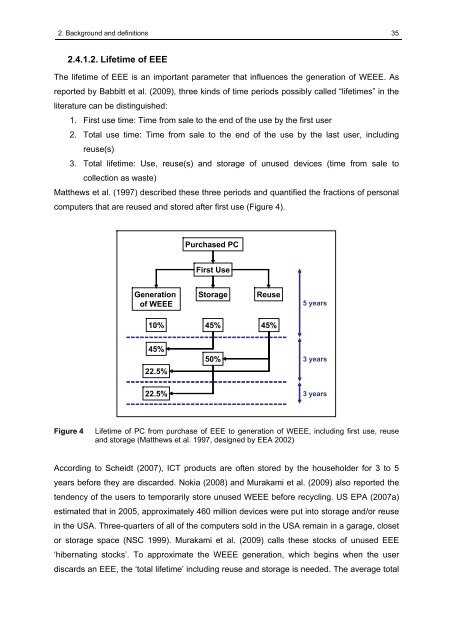SUbstance flow analysis of the recycling of small waste electrical ...
SUbstance flow analysis of the recycling of small waste electrical ...
SUbstance flow analysis of the recycling of small waste electrical ...
You also want an ePaper? Increase the reach of your titles
YUMPU automatically turns print PDFs into web optimized ePapers that Google loves.
2. Background and definitions 35<br />
2.4.1.2. Lifetime <strong>of</strong> EEE<br />
The lifetime <strong>of</strong> EEE is an important parameter that influences <strong>the</strong> generation <strong>of</strong> WEEE. As<br />
reported by Babbitt et al. (2009), three kinds <strong>of</strong> time periods possibly called “lifetimes” in <strong>the</strong><br />
literature can be distinguished:<br />
1. First use time: Time from sale to <strong>the</strong> end <strong>of</strong> <strong>the</strong> use by <strong>the</strong> first user<br />
2. Total use time: Time from sale to <strong>the</strong> end <strong>of</strong> <strong>the</strong> use by <strong>the</strong> last user, including<br />
reuse(s)<br />
3. Total lifetime: Use, reuse(s) and storage <strong>of</strong> unused devices (time from sale to<br />
collection as <strong>waste</strong>)<br />
Mat<strong>the</strong>ws et al. (1997) described <strong>the</strong>se three periods and quantified <strong>the</strong> fractions <strong>of</strong> personal<br />
computers that are reused and stored after first use (Figure 4).<br />
Purchased PC<br />
First Use<br />
Generation<br />
<strong>of</strong> WEEE<br />
Storage<br />
Reuse<br />
5 years<br />
10% 45%<br />
45%<br />
45%<br />
22.5%<br />
50%<br />
3 years<br />
22.5%<br />
3 years<br />
Figure 4<br />
Lifetime <strong>of</strong> PC from purchase <strong>of</strong> EEE to generation <strong>of</strong> WEEE, including first use, reuse<br />
and storage (Mat<strong>the</strong>ws et al. 1997, designed by EEA 2002)<br />
According to Scheidt (2007), ICT products are <strong>of</strong>ten stored by <strong>the</strong> householder for 3 to 5<br />
years before <strong>the</strong>y are discarded. Nokia (2008) and Murakami et al. (2009) also reported <strong>the</strong><br />
tendency <strong>of</strong> <strong>the</strong> users to temporarily store unused WEEE before <strong>recycling</strong>. US EPA (2007a)<br />
estimated that in 2005, approximately 460 million devices were put into storage and/or reuse<br />
in <strong>the</strong> USA. Three-quarters <strong>of</strong> all <strong>of</strong> <strong>the</strong> computers sold in <strong>the</strong> USA remain in a garage, closet<br />
or storage space (NSC 1999). Murakami et al. (2009) calls <strong>the</strong>se stocks <strong>of</strong> unused EEE<br />
‘hibernating stocks’. To approximate <strong>the</strong> WEEE generation, which begins when <strong>the</strong> user<br />
discards an EEE, <strong>the</strong> ‘total lifetime’ including reuse and storage is needed. The average total

















